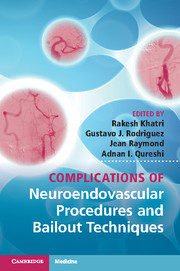Description
Complications of Neuroendovascular Procedures and Bailout Techniques
Coordinators: Khatri Rakesh, Rodriguez Gustavo J., Raymond Jean, Qureshi Adnan I.
Describes management of neuroendovascular complications, focusing on tips and tricks for 'bailout' procedures.
Language: English
Subjects for Complications of Neuroendovascular Procedures and...:
Publication date: 09-2016
224 p. · 16x24.1 cm · Hardback
224 p. · 16x24.1 cm · Hardback
Description
/li>Contents
/li>Biography
/li>
Neuroendovascular and neurointerventional therapy is a specialty where disseminating personal knowledge and expert opinion is extremely important, owing to the lack of large-scale clinical trials. The management of complications that occur during or immediately after therapeutic interventions is particularly challenging because these can significantly affect patient outcomes. This book presents how various complication scenarios are handled by well-qualified authorities in the field of neurointervention from three disciplines: neurology, neurosurgery, and neuroradiology. Contributors describe their management of these complications, focusing on the common principles that all the specialists agree on, and give tips and tricks for 'bailout' procedures to help get the practitioner out of trouble. The book is well illustrated and covers the full range of neuroendovascular and neurointerventional procedures. The book will appeal to neurointerventionists, neuroradiologists, stroke physicians, neurosurgeons and vascular surgeons for its practical approach to managing these commonly encountered problems.
List of contributors; 1. Groin complications during neuroendovascular procedures John Slaby; 2. Complications in endovascular embolization of intracranial aneurysms: prevention and bailout techniques Gustavo J. Rodriguez, Alberto Maud, Mushtaq H. Qureshi and Fernando Viñuela; 3. Complications associated with embolization of arteriovenous malformations and fistulas Hunar Kainth, Daraspreet Kainth, Karanpal Dhaliwal, Alberto Maud and Adnan I. Qureshi; 4. Complications during intracranial angioplasty and stent placement Farhan Siddiq and M. Fareed K. Suri; 5. Complications during the intra-arterial treatment of ischemic stroke Nazli Janjua and Rakesh Khatri; 6. Carotid angioplasty and stenting: complication avoidance and management Ramachandra P. Tummala; 7. Complications with extracranial stenting other than carotid stenting Rakesh Khatri; 8. Complications during head and neck embolization Asif Khan, Rakesh Khatri and Jefferson T. Miley; 9. Complications during endovascular provocative testing and bilateral inferior petrosal sinus sampling Ameer E. Hassan, Haralabos Zacharatos, Gustavo J. Rodriguez, and Ricardo Hanel; 10. Role of neurocritical care in prevention and treatment of acute respiratory, cardiovascular, and neurological complications in the angiographic suite Tenbit Emiru, Jose I. Suarez and Adnan I. Qureshi; 11. Periprocedural planning for neuroendovascular procedures Alluru S. Reddi, Wondwossen G. Tekle and Neil Kothari; 12. Relevant pharmacology for neurovascular procedures James J. Roy, Megan R. Burns and Bryan M. Statz; 13. Radiation-related complications of neuroendovascular procedures Venkata K. Lanka; Index.
Rakesh Khatri is Director of the StrokeCareNow Network and Director of Vascular Neurology, Neurocritical Care and Neurointervention at the Fort Wayne Neurological Center, Indiana.
Gustavo J. Rodriguez is Associate Professor and Vice Chair of the Department of Neurology, and Clinical Associate Professor of the Department of Radiology at the Paul L. Foster School of Medicine, Texas Tech University Health Sciences Center.
Jean Raymond is Professor at the Department of Radiology, Oncology and Nuclear Medicine at the University of Montreal, and Director of the Interventional Neuroradiology Research Laboratory at the University of Montreal Hospital Research Centre (CRCHUM).
Adnan I. Qureshi is Associate Head and Professor at the Zeenat Qureshi Stroke Research Center, Department of Neurology, University of Minnesota.
Gustavo J. Rodriguez is Associate Professor and Vice Chair of the Department of Neurology, and Clinical Associate Professor of the Department of Radiology at the Paul L. Foster School of Medicine, Texas Tech University Health Sciences Center.
Jean Raymond is Professor at the Department of Radiology, Oncology and Nuclear Medicine at the University of Montreal, and Director of the Interventional Neuroradiology Research Laboratory at the University of Montreal Hospital Research Centre (CRCHUM).
Adnan I. Qureshi is Associate Head and Professor at the Zeenat Qureshi Stroke Research Center, Department of Neurology, University of Minnesota.
© 2024 LAVOISIER S.A.S.




